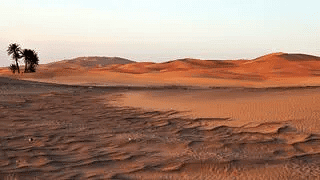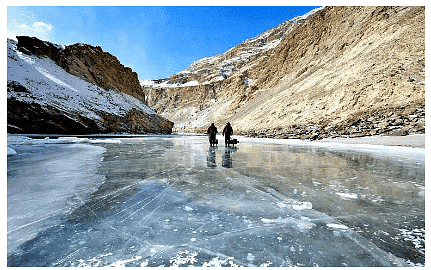Class 7 Exam > Class 7 Notes > Social Studies (SST) Class 7 (Old NCERT) > NCERT Summary: Life in the Deserts
Life in the Deserts Summary Class 7 Geography Chapter 7
| Table of contents |

|
| Introduction |

|
| The Hot Desert – Sahara |

|
| The Cold Desert – Ladakh |

|
| Conclusion |

|
| Important Places and Definitions |

|
Introduction
- Living in deserts presents unique challenges and adaptations for the people who call these regions home.
- In this discussion, we will explore the intricacies of life in two types of deserts: hot deserts and cold deserts.
The Hot Desert – Sahara

Location of Sahara
- The Sahara Desert is a vast expanse in North Africa, covering approximately 8.54 million square kilometers.
- It stretches across eleven countries, namely Algeria, Chad, Egypt, Libya, Mali, Mauritania, Morocco, Niger, Sudan, Tunisia, and Western Sahara.
Geographical Features
- The Sahara is not merely an endless sea of sand. It comprises gravel plains and elevated plateaus, with some rocky surfaces rising to heights of over 2500 meters in places.
Climate
- The climate in the Sahara is scorching hot and remarkably dry.
- Rainfall is meager, and the region experiences a short rainy season.
- During the day, temperatures can reach an astonishing 50°C, heating up the sand and rocks, which then radiate heat into the surroundings.
- Nights can be freezing cold, with temperatures plummeting to nearly zero degrees.
Flora and Fauna
- While we might envision deserts as barren places, the Sahara surprises with some hardy vegetation.
- Cactus, date palms, and acacia trees manage to thrive in certain areas.
- There are pockets of green oasis with lush date palms.
- Animal life includes camels, hyenas, jackals, foxes, scorpions, and a variety of bird species.
People and Activities
- Two distinctive groups, the Bedouins and Tuaregs, are nomadic tribes that rear livestock such as goats, sheep, camels, and horses.
- These animals provide essential resources, including milk, hides for making leather products, and even hair for crafting mats, carpets, clothes, and blankets.
- Bedouins and Tuaregs often wear heavy robes to protect themselves from dust storms and the scorching desert winds.
- Near the oases, where water is available, there are settled populations engaged in agriculture.
- Crops such as rice, wheat, barley, and beans are cultivated, and Egypt’s world-famous cotton thrives in the Nile Valley.
- The Sahara also holds valuable natural resources, notably oil.
- Modernization, accompanied by the discovery of oil and other minerals like iron, phosphorus, manganese, and uranium, is transforming the Sahara and impacting the lives of its inhabitants.
Changes in Sahara
- The cultural landscape of the Sahara is evolving rapidly.
- Gleaming office buildings now rise above ancient mosques, and modern superhighways intersect the paths once trodden by camels.
- Trucks are supplanting camels in the salt trade, and even nomadic herdsmen are transitioning to city life, finding jobs in oil and gas operations.
The Cold Desert – Ladakh

Location of Ladakh
- Ladakh, situated in the northernmost part of India within the Great Himalayas, is a cold desert.
- Its unique location places it within the union territory of Jammu and Kashmir.
Geography and Climate
- Ladakh is enclosed by the formidable Karakoram Range to the north and the Zanskar Mountains to the south.
- Altitude within the region varies significantly, from around 3000 meters in places like Kargil to over 8000 meters in the Karakoram.
- The climate in Ladakh is characterized by extreme cold and dry conditions.
- Due to its high altitude, the air is thin, making the sun’s heat intense.
- In summer, daytime temperatures hover just above zero degrees, while nights can dip well below -30°C.
- Winters are even harsher, with temperatures frequently remaining below -40°C.
Flora and Fauna
- The scarcity of moisture in Ladakh results in sparse vegetation, with only pockets of grasses and shrubs.
- However, during the summer, fruit trees like apples, apricots, and walnuts bloom in the region.
- Birdlife is diverse and includes species like robins, redstarts, Tibetan snowcock, ravens, and hoopoes.
- Animal life consists of wild goats, wild sheep, yaks, and unique regional dog breeds.
- These animals are crucial for providing milk, meat, and hides.
- Yak’s milk, for example, is used to produce cheese and butter, contributing to the local diet.
People of Ladakh
- Ladakh’s inhabitants are primarily either Muslims or Buddhists.
- The region boasts numerous Buddhist monasteries, known as ‘gompas.’
- Some of the most well-known monasteries include Hemis, Thiksey, Shey, and Lamayuru.
- In the summer season, people are occupied with the cultivation of barley, potatoes, peas, beans, and turnips.
- However, the harsh winter months dictate a different lifestyle, with residents engaging in various festivities and ceremonies.
- Ladakhi women, in particular, play a crucial role not only in household and agricultural activities but also in managing small businesses and shops.
- In terms of connectivity, Leh, the capital of Ladakh, is well linked to the rest of India via both road and air travel.
- The National Highway 1A connects Leh to the Kashmir Valley, passing through the challenging Zoji La Pass.
Tourism and Conservation
- Ladakh attracts numerous tourists due to its stunning monasteries, the lure of treks through meadows and glaciers, opportunities to witness local ceremonies and festivities, and its unique culture.
- However, it is essential to balance the influx of tourists with conservation efforts in this fragile environment.
- As Ladakh modernizes and adapts, the region’s cultural landscape is also undergoing significant changes.
Conclusion
- In conclusion, life in deserts presents a myriad of challenges, but it also showcases human adaptability and the remarkable ability of communities to thrive in extreme conditions.
- From the hot deserts of the Sahara to the cold deserts of Ladakh, these unique environments have shaped the cultures, livelihoods, and landscapes of the people who call them home.
Important Places and Definitions
- Deserts: Arid regions characterized by extremely high or low temperatures and has scarce vegetation. Deserts are defined by their challenging climate conditions, including limited precipitation and a wide range of temperatures.
- Oases: Depressions in deserts where underground water reaches the surface, forming fertile areas. Oases are vital in desert regions, providing water and supporting agriculture.
- Gompas: Buddhist monasteries commonly found in the Ladakh region. These monasteries are significant cultural and religious centers.
- Zoji La Pass: A high mountain pass in the Himalayas that connects Ladakh to the Kashmir Valley. This pass is essential for transportation between the two regions and is known for its challenging terrain and weather conditions.
- Bedouins: Nomadic tribes in the Sahara and other desert regions, known for their traditional way of life and expertise in desert survival.
- Tuaregs: Another nomadic tribal group, primarily found in the Sahara. They have a distinct culture and are known for their blue clothing and turbans.
- Altitude: The height above sea level. In Ladakh, altitude varies significantly, affecting the climate and the ability to adapt to high-altitude conditions.
- Karakoram Range: A mountain range located in northern Pakistan, India, and China. It is one of the Greater Ranges of Asia and is home to some of the world’s highest peaks, including K2.
- Zanskar Mountains: A mountain range in the Ladakh region of India, known for its rugged and dramatic terrain.
- Precipitation: Any form of water—liquid or solid—that falls from clouds and reaches the ground. In deserts, precipitation is typically very limited.
- Cactus: A type of succulent plant adapted to arid conditions, often found in desert regions.
- Acacia: A type of tree or shrub known for its adaptability to dry climates and is found in some desert areas.
- Camels: Large, humpbacked mammals often referred to as the “ships of the desert” due to their ability to carry heavy loads and survive in arid environments.
- Nomadic: Refers to groups or communities that do not have permanent settlements and move from place to place in search of resources.
- Oil: A valuable natural resource extracted from the Earth, often found in desert regions and used for various purposes, including energy production.
- Iron: A metallic element and valuable mineral resource used in manufacturing and construction.
- Phosphorus: A chemical element and essential nutrient often used in fertilizers.
- Manganese: A metallic element and important industrial mineral used in steel production and other applications.
- Uranium: A radioactive element used in nuclear energy and various applications.
- Buddhist Monasteries: Religious and cultural institutions in Ladakh where Buddhist monks live, worship, and study.
- Kashmir Valley: A fertile region in the northern part of the Indian subcontinent, known for its scenic beauty and cultural significance.
The document Life in the Deserts Summary Class 7 Geography Chapter 7 is a part of the Class 7 Course Social Studies (SST) Class 7 (Old NCERT).
All you need of Class 7 at this link: Class 7
|
63 videos|371 docs|46 tests
|
FAQs on Life in the Deserts Summary Class 7 Geography Chapter 7
| 1. What adaptations do plants and animals in deserts have to survive in harsh conditions? |  |
Ans. Plants and animals in deserts have developed various adaptations to survive in harsh conditions. Some plants have deep root systems to reach underground water sources, while others have thick waxy coatings to prevent water loss. Animals may be nocturnal to avoid the extreme heat during the day or have specialized ways of obtaining water from their food.
| 2. How do desert ecosystems support life despite the extreme conditions? |  |
Ans. Despite the extreme conditions, desert ecosystems support life by having specialized plants and animals that have adapted to survive in these harsh environments. Some plants store water in their tissues, while animals like camels can go for long periods without water.
| 3. What are some of the challenges faced by organisms living in deserts? |  |
Ans. Organisms living in deserts face challenges such as limited water availability, extreme temperatures, and scarcity of food. They must have adaptations to cope with these challenges, such as the ability to conserve water or regulate body temperature effectively.
| 4. How do desert plants contribute to the ecosystem? |  |
Ans. Desert plants play a crucial role in the ecosystem by providing food and shelter for other organisms. They help prevent soil erosion and contribute to nutrient cycling in the desert ecosystem. Some plants also have symbiotic relationships with animals, providing them with food or shelter.
| 5. How do desert animals obtain water in arid environments? |  |
Ans. Desert animals have various ways of obtaining water in arid environments. Some animals get water from their food sources, while others can extract moisture from the air they breathe. Animals like camels have specialized kidneys that allow them to conserve water efficiently.
Related Searches















